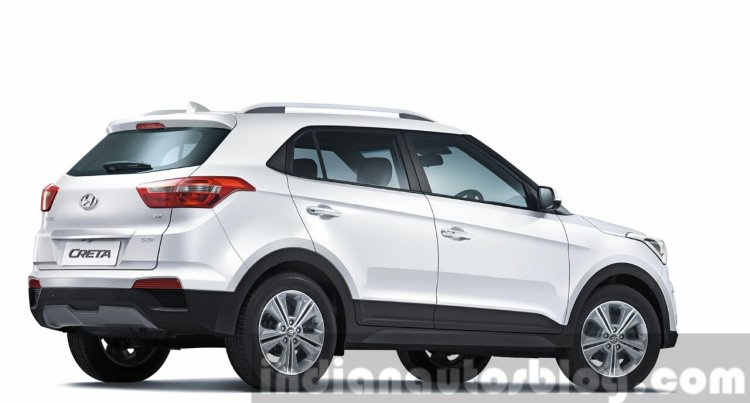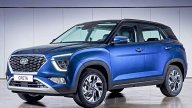Hyundai Creta - First Drive Review
Hyundai Motor India Limited (HMIL) conducted the premiere of the Creta compact SUV at its plant in Chennai today. Post the reveal, HMIL allowed us a 10 minute spin on the Creta, and the following is our brief driving impression of the car.
Hyundai Creta Exterior:

The exterior of the Hyundai Creta is identical to the Hyundai ix25 sold in China, save for the chrome-plated rear registration plate enclosure. While Hyundai India are yet to release the dimensional specifications of the Creta, expect the overall length to be around 4.27 meters.
The Creta will launch in a total of four variants - Base, S, SX and SX (O). The SX (O) gets projector headlights with LED daytime running lights, 17-inch 215-width diamond-cut alloy wheels, chrome door handles, rear wiper and washer and wing mirror integrated turn signals.
As mentioned earlier, the Creta looks like a smaller Santa Fe, and its design is sure to be appreciated by Indian buyers.
Hyundai Creta Interior:

The interior of the Creta is everything one would expect in a modern Hyundai - Solid build quality, well executed design and layout, and a spacious, feature-packed cabin.
On the Creta though, Hyundai have taken their premium interior a step above. For example, the doors have a solid VW-like feel when you open and shut them. Further, the door pads on the top-end Creta SX (O) are lined with leather with contrast white stitching, what is normally seen on a luxury brand.
The view from the driver’s seat is what one would expect from a compact SUV: neither do you get the feeling of sitting two storeys high, nor a hatchback, it’s perfectly in-between.
The Creta’s cabin will be familiar to anyone who has spent time inside an Elite i20, or a Verna. A leather-wrapped 3-spoke steering wheel rests in front of the “Supervision Cluster”, while vertical HVAC vents surround a 7-inch touchscreen AVN (Audio, Visual and Navigation) system. Below the AVN system is the fully-automatic climate control system, and below that Hyundai have provided generous space to store your phone or media device.

Getting in and out of the seats prove extremely easy thanks to the wide opening doors, and the relatively high-set rear bench. The rear bench is one of the wider ones in this segment, and can accommodate three with reasonable comfort.
Legroom at the rear is generous, to put it in perspective, about 10 percent more than an Elite i20. The seat back (even on the top-end, the Creta will not offer split-folding rear seats, its a single piece) has a relaxed position to it, while under-thigh support is more than satisfactory.
The boot is well shaped and has a relatively low loading lip. The boot volume is expected around the 400 liter mark. It is worthy to note that the Creta comes with a full-sized alloy spare wheel.
Other noteworthy features on the Creta include a 6 speaker audio system, smart key with push button start, 6 airbags, leather seats, shark fin antenna, FATC with ionizer, rear AC vents, steering controls, 1 GB internal storage, and electric folding wing mirrors.
Hyundai Creta Engine and Gearbox:

We took a brief spin in the Creta diesel 1.6 MT and AT. Refinement levels of this VGT unit are easily best in segment. At idle, its very hard to make this out to be a diesel engine.
At 128 PS, the Creta diesel makes the same amount of power as the Verna 1.6. However, the Creta actually feels quicker and more agile than the sedan. Post 2,000 rpm, this engine hits its sweet spot and there is sufficient grunt to pin you to the seats. At city speeds of say 20 km/h in third gear, it takes the Creta a moment to get past its turbo-lag and get a move-on.
The gearbox is very Verna like: Throws are short and accurate, and the clutch is relatively light as well.

Coming to the Creta 1.6 AT, Hyundai is offering a 6-speed automatic transmission for its compact SUV. On the move, upshifts are extremely smooth and occur progressively at about 2,000 rpm. Downshifts are pretty quick to, and the Creta AT does not feel like its dragging a slow-shifting gearbox.
Driving the MT and AT back-to-back, it does appear that performance has taken a small cut on the AT, but we reckon the clutch-free driving experience will be better appreciated.
Hyundai Creta Ride and Handling:

Since the Creta was tested within the confines of Hyundai’s butter smooth test track, we wouldn’t be able to give a definite verdict here. However, the Creta is extremely promising in this department.
Body control feels tight, and though it’s not involving to drive as say an EcoSport, this is Hyundai’s best handling car till date, we felt. Even the steering feel, which is a downer on Hyundai products, appears decent on the Creta and is miles ahead of the Verna. Courtesy of the Creta’s road manners is its HIVE body structure, made of high-tensile strength steel, which promises increased rigidity.
As we said, the Creta feels very promising in this department, but only a full road-test will bring out its characteristics.
Hyundai Creta Brakes and Safety:

The SX (O) variant of the Creta will come equipped with six airbags, ABS, EBD, VSM, HAC (Hill Ascent Control) and ESC, which can be turned off if necessary. The test track’s straight road gave us an opportunity to check out the brakes of the Creta which are extremely powerful and confident inspiring to use. For reference, the Creta SX (O) rides on 17-inch 215-width tyres.
Verdict:
Its evident that Hyundai has not held back with the Creta, which according to reports has cost the carmaker INR 1,000 Cr to develop. And the efforts have certainly borne fruitful as the Creta comes across as a well-packaged, high-quality product.
The compact SUV appeals on all fronts; the looks, interior design and build quality, space and equipment, engine and gearbox, and even ride and handling to a large extent. While we would definitely need to spend more time with the car for a proper road-test, Hyundai appears to have another winner on its hands.











